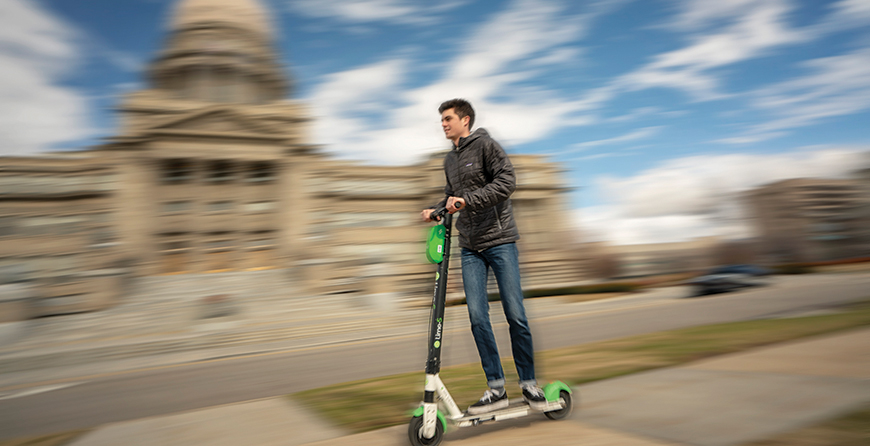If you spend any time in Downtown Boise, chances are you’ve seen Meredith Stead, dressed in high heels and business attire, cruising around on
an e-scooter.
Stead lives downtown, making for a walkable and bikeable commute to the Boise Valley Economic Partnership office, where she works as the marketing and events manager. But if she’s running late, or if she’s bopping home for a minute, or if those high heels make her think twice about walking, Stead hops on a scooter and scoots to wherever she’s going.
Stead usually pays about $2 to travel about one mile using either of the e-scooter companies, Lime and Bird. She says the scooters are timesavers and offer a welcome change of pace.
“They add serious joy to my day,” she says. “Most people riding them are smiling for a reason.”
Stead isn’t the only Boisean to embrace e-scooters. Since Bird and Lime started operating in Boise in October, nearly 38,000 unique riders had taken nearly 12,400 rides through Jan. 28, city of Boise spokesman Mike Journee says.
The combination of high usage and few accidents has convinced the Boise City Council to look into expanding the number of e-scooters on the streets. The council expects to vote on a proposal by mid-March that would allow a third company, Spin, to operate in Boise and triple the number of e-scooters in circulation to 1,500, Journee says.
Mayor Dave Bieter supports expansion, though he’s said the city needs to be cautious about allowing too many e-scooters too quickly. But he, like the council members supporting the proposal, likes the idea of providing transportation options that help reduce auto traffic, Journee says.
“If expansion can be done in a way that doesn’t disrupt things or where scooters aren’t piling up in front of businesses or thrown into rivers, it could prove to be a real boon for the community,” he says.
E-scooters have created problems in other cities, including in Meridian. Lime briefly offered e-scooters in Meridian before coming to Boise in early October. Riders left e-scooters on sidewalks or blocked wheelchair ramps, prompting the city to halt the service. Meridian is working with Boise on an ordinance that could restart e-scooter operations in the coming months.
While the rollout in Boise was relatively smooth compared to other cities, there were some hiccups. The Idaho Statesman reported that on Oct. 29—the weekend before Halloween—a man wearing a dinosaur costume fell off of a moving e-scooter in a crosswalk and injured a woman dressed as the cartoon character Rainbow Brite.
In January, the Idaho Statesman reported that one scooter had been dumped into the Boise River, and that the city had received 75 complaints related to e-scooters. One of the complainants reported that riders were using their e-scooters to draw pictures in the snow near the Clearwater Building, according to the Statesman.
Because users can ride e-scooters as far as they want to go (see sidebar), the devices end up all over Boise and Garden City, and occasionally beyond. But Bird and Lime also distribute them to various neighborhoods, and there are discussions about comping scooter rides for those using e-scooters to catch buses run by Valley Regional Transit, Journee says.
Stead, who sometimes takes several e-scooter rides in a day, says she supports expanding the program. Sometimes, she can’t find an e-scooter within a few blocks. Sometimes, like on a recent ride to a winery in Garden City, another user will take her scooter, which means she hails the Lyft rideshare service or finds another way home.
But Stead says adding too many scooters to Boise streets could cause problems. The trick, she says, is finding the right balance for encouraging non-auto travel without making scooters
so ubiquitous that they are taken
for granted.
“If you get too many, people may start treating them like trash instead of valuable means of transportation,” she says. “We would want to be sure that our market requires more and would find use in adding more.”
What Are E-Scooters, Anyway?
Several companies offer dockless electronic scooters for paying riders in Boise and beyond, but all work roughly the same way. Customers use downloaded e-scooter apps on their smartphones to locate scooters nearby. They then use their phones to scan a code on the scooters to unlock them. They use the e-scooters to travel up to 15 mph at a cost of $1, plus a per-minute charge that varies by company. The average ride in Boise is a little over a mile, at a charge of under $2.
In Boise, e-scooters can legally travel in streets, as well as on sidewalks and on the Greenbelt.
Riders can drop off scooters anywhere. The e-scooters are retrievable thanks to GPS. Companies pay employees or independent contractors to gather and charge its e-scooters each night and deliver them to designated spots around town where users can expect to
find them.

